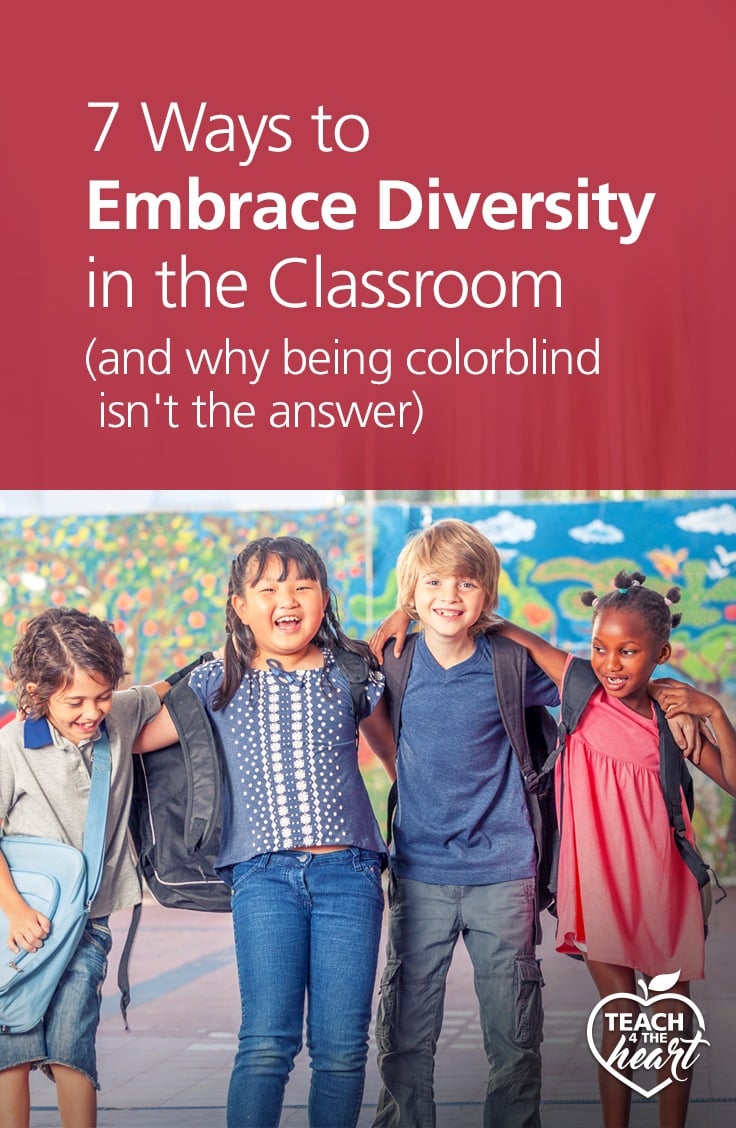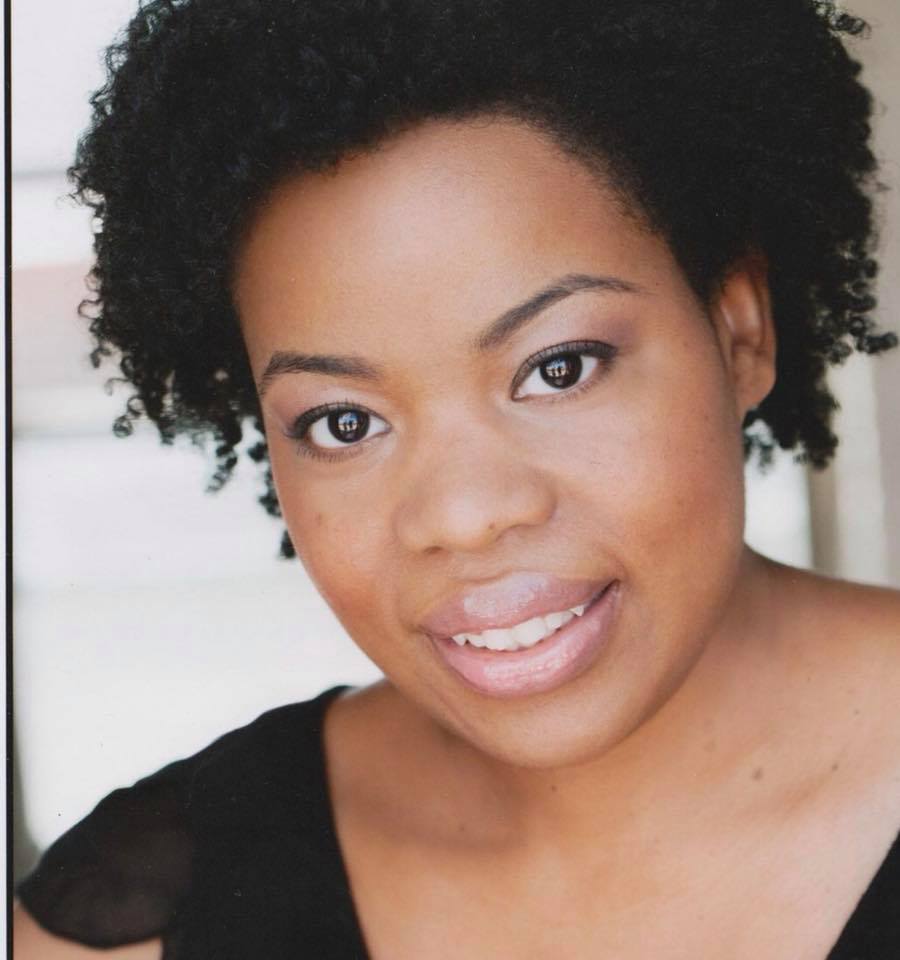
Making our classroom a welcoming and diverse place is more important than ever. We need to ensure that all of our students feel comfortable and that they are exposed to a variety of cultures and races. We will share why diversity in the classroom is important and how to make it happen.
listen here:
a common question about diversity in the classroom
A lot of times when talking about diversity, we hear, “Shouldn’t we be colorblind? Doesn’t bringing up race and culture just contribute to the problem?” This can be a well-intentioned question, but let’s look at why being “colorblind” isn’t the best way. Let’s start by looking at the definition of it.
The dictionary definition of colorblind is “not influenced by differences of race, especially: free from racial prejudice.” However, the Antiracist definition is ‘“not seeing” race or ignoring race.” As teachers, we need to be aware that if we say “I am colorblind,” we might mean the dictionary definition, but our students often hear the Antiracism definition and assume we don’t see them for who they are. This is hurtful, so it’s better not to use this term.
Do we want to be free from racial prejudice/partiality? For sure! Do we want to ignore race, though? No, we shouldn’t. Let’s continue to talk about why.
Why shouldn't we be colorblind?
- Many biases result from misunderstanding- Sadly, racism and bias still happen. Many people still look down on others based on their race, nationality, or culture. The world sees color, even if you individually don’t. If this weren’t the case, maybe we could simply ignore race. But since racism IS happening, we need to be active in opposing it.
- We should celebrate God’s beautiful diversity- God has given us beautifully different cultures and experiences, and our lives and education are enriched for seeing and understanding them. Acknowledging someone’s differences (and different doesn’t mean bad!) helps validate their experience. Stories also often show us that, though we are different, we experience the same emotions. They help us celebrate both our differences AND our shared similarities.
- Diversity rarely happens without intentionality- It may feel strange at first to intentionally seek out books or pictures that portray POC (people of color), but ask yourself, “Does my library naturally reflect diverse cultures without my being intentional about it?” If so, then great! But chances are, it doesn’t. Chances are, if you look at it, it’s NOT diverse. There’s a variety of reasons for this, but the point is that if it’s not happening naturally, then we have to infuse intentionality to make it happen. All your students need to see that people who look like them write books and have done amazing things. On the flip side, they also need to know that people who don't look like them write books and do amazing things. Don’t assume your students already know this.
Biases often result from misunderstanding someone else. Not every student lives in a diverse area and interacts with others who are different than them, so we need to be proactive in providing diverse content. By diversifying our books, stories, etc., we can help our students better understand and appreciate each other rather than stereotyping or judging.
If you want to explore this question further, Neil Shenvi quite helpfully examines all angles in his articles here and here.
The point is, within the classroom, it's probably not helpful to completely ignore our cultural and ethnic differences but to instead embrace and celebrate them. Here are 7 ways to do this:
7 ways to embrace diversity in the classroom
1. Diversify classroom libraries and signage
Be sure that you intentionally incorporate a variety of perspectives and authors in your classroom libraries, including abilities (people with disabilities are not always represented). When choosing cultural texts, ensure that there is more than one perspective. For example, if there is a book about slavery, make sure there are also people and accomplishments mentioned from that era (Phyllis Wheatley or Congo Square for example). Traditional African books, the Harlem Renaissance, and biographies about leaders and inventors of color are all ways to diversify the narrative. Make sure your books don’t just focus on the hardships of a certain race or culture, but also their accomplishments. Need ideas? Start with our book list at the bottom of this article.
When students are looking around, staring off in the distance even, what do they see? Are they looking at a diverse set of faces that reflect American society or do all the faces represent one group? If you don’t have images, do you have quotes that are representative people of various perspectives and backgrounds?
2. Choose diverse books for read-alouds and assigned readings
It’s important that engagement and recognition of all voices is not simply a passive approach. You don't need to make an announcement about "honoring all voices this year” (unless of course you choose), but it should be observable. Your actions are what students believe to be more authentic than just your words. Books we choose to read as educators or assign students to read on their own should be intentionally diversified on our part until it is a part of the norm and will no longer require much thought.
An example of this is when Kipp Charter schools had a unit on artists as part of their 3rd grade ELA curriculum. In that unit, the students studied the books Emma’s Rug (about a young Chinese girl finding artistic inspiration), When Marian Sang (about singer Marian Anderson who sang in pre-Civil Rights America), A River of Words (about poet William Carlos Williams) and Action Jackson (about Jackson Pollock). Not only were the types of art diversified, but so were the artists themselves. Marian Anderson was discriminated against, which came up during the study, in addition to the other artists’ experiences. All of their lives and experiences were explored within the context of the reading.
For older kids there are a variety of books as well, The House on Mango Street (about a Chicana girl growing up in the Hispanic quarter of Chicago), The Bluest Eye (about an African-American girl in 1941), and The Scarlet Letter (themes of discrimination) are all popular choices.
3. Celebrate heritage months
If it’s not already weaved into the curriculum (we will talk more about that later), Heritage Months are a great way to celebrate diversity in the classroom and place a variety of cultures in a positive light. We will also learn more ourselves as we research. If we’re not used to doing this, it can be easily forgotten, so it’s best to plan over the summer or during the overall unit planning.
Recognizing Heritage Months can be as simple or as elaborate as you like. You can:
- Welcome guest speakers or performers to share their experience first-hand.
- If you or a staff member are used to creating performances and assemblies, have the students perform work written by someone from the culture being represented. This could be music, poetry, speeches, research spoken in the form of living museums, etc. If you have older kids, encourage them to show their talents by writing or choreographing their own work based on a topic or representation from the culture and put it together as a review.
- Be sure to include books and assign homework readings, projects or bell ringers for a brief discussion that focus on a new figure or key point throughout the month.
- Highlight one key figure a day over the PA (Public Announcement) system in a 2-3 minute announcement. You can choose reliable students, fellow teachers, or get your class covered to get the announcement done. It’s best to plan all key figures for the month at one time so as not to run out of time or people to announce.
- Decorate a bulletin board or your door to highlight something from the culture being represented. This is a great time to get adult family members and/or students involved. You can provide the supplies and give them creative freedom as you continue to teach or tackle other tasks. If your school is willing, you can have a door decorating contest and the winning class can win a treat or special privilege.
The key to this is to dive deeper than usual into the cultures, and not just focus on Dr. Martin Luther King Jr. or even Black History Month. Celebrate Women’s History Month where you can most definitely include white women and underrepresented cultures. If you try to incorporate them all (even if you first start with one and build each year), you are then showing that all contributions are valuable.
The current Heritage Months include:
September 15th-October 15th Hispanic Heritage Month
October- Italian American Heritage Month November- Native American Heritage Month
February- Black History Month
March- Women’s History Month
May- Asian and Pacific American Heritage Month
Celebrating other cultures changes the narratives that one culture or group is more valuable than another. We can’t take for granted that students know more than what they see on the news or even hear from certain family members. If students are only seeing white males as leaders, authority figures or people to be respected, how will non-white male students perceive their own opportunities? How do we really know that students are seeing everyone as equally valuable and great contributors to the American fabric? We as teachers know that students’ thoughts taking shape today can have an impact on their lives tomorrow.
4. reflect diversity during performances
Beyond Heritage Months, if you are a music teacher, theater teacher or you study plays and art in your classes, try ensuring that you include work from a variety of artists if you haven’t already.
For example, you can pick a theme and explore it across genres and cultures throughout the year. For example, with the theme “love and hate,” your class can explore Romeo and Juliet, West Side Story, and Once on this Island. In this, students can see the differences between Italian, Hispanic, White American, and Haitian cultures, but also the sameness of the human experience. After this, students can write their own pieces based on the theme to validate their own creativity and lived experiences. Hearing from students (not in a way to single them out) validates their experiences and we all learn from each other as well.
If you are using scripted plays and choose not to blind cast (but stick with the races represented in the play), it’s really important to diversify the plays. If there is not enough representation in your student body, please don’t be afraid to blind cast. Taren once played Hamlet in High School even though she’s an African-American female. Other students assumed that one of her white male peers would land the role but luckily the casting directors looked past race and gender. This is one time when being what the world calls "colorblind" can be positive- to make sure we are providing the same opportunities to all students. Remember, however, to be aware of avoiding cultural appropriation with certain songs or plays.
5. Encourage classroom community
We all know that our classroom community is important. You can help build positive relationships among classmates with these ideas.
- It’s important for students to feel included even with uniqueness. If they are being excluded or singled out by peers, let students know it’s inappropriate and leave it as that. Do not use that as a time to go on and on about inclusion. Perhaps it will be something to come back to at another time in a way that the student doesn’t feel singled out.
- Have a class ritual where there are times when you’ll ask about their weekend, break or what they had for dinner, something common about their lives that may have uniqueness within. You will be surprised at what you begin to discover and can keep in mind as you continue to share the space together.
- Talk about current news topics and listen to their perspective. If you hear anything problematic, encourage them to see the other perspective or to think objectively.
- Encourage students to build relationships with each other. Everyone has good and bad traits. If someone does something inappropriate or makes someone else uncomfortable, teach them not to fall into the habit of relying on an authority figure to intervene but to look out for each other, assume the best (maybe the intention wasn’t the way it seemed), and to tell the other person what they need to have happen in order to move forward. For example, “I felt frustrated when you took my pencil during group work” or “You know that was my pencil right? Next time can you ask first, even if you were just planning to use it for a second?” We’ve seen in recent events situations escalating because people don’t know how to talk to each other and advocate for themselves in a peaceful way. We can teach students to work with each other, rather than build up walls.
- Learn to properly pronounce students’ names. Dismissing it as too hard is dismissing a part of them and can be disrespectful. Also, ask yourself, is it really that hard? If it really is, respectfully ask if they go by a nickname. If not, remember we ask them to challenge themselves daily. This would be a good time for us to do the same.
- Use students’ names during word problems or examples you create during math and other subjects where names are typically generic or not representative of different cultures.
- Think about changing exclusive language. For example, change language from “Mom and Dad” to “Family.” You could say, “Remember to invite your families’ or ‘…the adults at home to the awards ceremony.’
6. Evaluate Dress code
If you are responsible for enforcing or maintaining a dress code, be sure that the parameters are meaningful and purposeful and not based on cultural preferences or an unconscious preference for assimilation. For example, most African-American hair grows in a manner similar to an afro in its natural or ‘wash and go’ state. The best way to “manage” it is typically not a pony tail.
Cultural techniques have included relaxers to make the hair appear straight and to easily manage, but techniques also include braids, twists and dreadlocks to name a few. These things don’t necessarily relate to education but it’s important to be aware that such differences exist and may not always be what society has deemed as “professional.” However, some dress codes surrounding hair style preferences may very well be exclusive. The same is true for cultures or religions (even represented in Christian schools) that require head covering.
7. expand the Curriculum
It’s not uncommon to hear in the adult world, “I didn’t learn that in school” across racial backgrounds. In some areas, we think it’s the parents’ jobs and in turn, the parents leave it up to the schools. This includes children growing up without a typical family structure. In the end, whose job is it to teach race and inclusion? Do we really live in a society where adults grow up and dismiss one’s humanity, especially when they are different? For some of us, we inadvertently benefit from such a society where we can carry on without a care. However, as teachers, we are at a great vantage point to truly see the humanity in all people and encourage our students to do the same, so that they learn that anything less is unacceptable.
We must educate ourselves to expand the curriculum. Let’s not glaze over parts of American History that consists of one page mentioning minority cultures. Let’s really consider the questions: “What were other cultures doing at each point in history?” and “What contributions did they make?” Let’s weave that into our lessons. If you find that to be challenging with time constraints, homework and bell ringers are reliable ways until you can incorporate more.
If we don’t see diversity in the classroom as important, we must ask ourselves, “Why?” It’s not enough to “not see color.” The truth is, the world does and by saying you don’t see it, you are denying the richness of the diversity and the unique challenges it also brings growing up in our society. It doesn’t teach children that all people have contributed to society, some that look like them and some that do not. Seeing color shows that we recognize each other’s cultures and don’t have to be the same color to value each other, live, study, and work together. It shows that difference isn’t bad. It’s good as it brings fresh perspectives and ideas.
List of diverse books for the classroom
A great place to start when diversifying your classroom library is by looking at race-based awards for book ideas such as the Coretta Scott King Book Award, Pura Belpre Award, Asian/Pacific American Award for Literature, and the American Indian Youth Literature Award. The books below have been recommended by fellow teachers.
Disclaimer: We have not vetted all of these book choices. Please use your discretion and district guidelines when selecting books.
Elementary
All the Colors We Are (Also in Spanish)
Addy: Finding Freedom (and sequel A Heart Full of Hope)
Kaya: The Journey Begins (and sequel Smoke in the Wind)
Josefina: Sunlight and Shadows (and sequel Second Chances)
Nanea: The Spirit of Aloha (and sequel Hula for the Home Front)
Hair Like Mine (and sequel Skin Like Mine)
How Many Days to America?: A Thanksgiving Story
Jabari Jumps (and sequel Jabari Tries)
The Proudest Blue: A Story of Hijab and Family
The Princess and the Warrior: A Tale of Two Volcanoes
Meet Yasmin! (There are more than 12 books in this series!)
middle school
Jefferson’s Sons: A Founding Father’s Secret Children (extramarital relations implied)
My Life as an Ice cream Sandwich
high school
Courage to Soar: A Body in Motion, A Life in Balance
Black Boy (sexual content)
Dear Martin (explicit language)
The Hate You Give (explicit language)
christian
Clubhouse Jr. (Christian Magazine)
He’s Got the Whole World in His Hands
One Big Heart: A Celebration of Being More Alike than Different
Children of God Storybook Bible
The Jesus Storybook Bible: Every Story Whispers His Name
I Am, God’s Affirmations for Little Girls
I Am, God’s Affirmations for Little Boys
Maybe I Can Love My Neighbor, Too
The Tiny Truths Illustrated Bible
A Saint in the City: Stories of Champions from the Barrio
The Prince Warriors (series)
for more book ideas...
- Any books by the authors Jacqueline Woodson, Kwame Alexander, and Saadia Faruqi
- 30 page (paid) booklist from The Tutu Teacher
- Booklist from Social Justice Books
If you want to learn more about racial unity, check out the articles How to Pursue Racial Unity (The Gospel vs. Critical Race Theory) and How to Cross the Street on Race & Take a Restorative Approach to Discipline.
If you want to learn more about racial unity, check out the articles How to Pursue Racial Unity (The Gospel vs. Critical Race Theory) and How to Cross the Street on Race & Take a Restorative Approach to Discipline.
does your heart crave even more?
Consider signing up for the Teach 4 the Heart Podcast. This free resource is one additional way you can receive Gospel encouragement and practical teaching tips grounded in a Biblical worldview. Oh, and it's totally FREE!
Make sure you never miss an episode: Click here to learn how.
about taren mangual
Taren is a Christian educator with a passion for studying humanity and its ability to create. She has a BFA from Marymount Manhattan College and a MA in Educational Theatre from NYU. Taren worked for over five years as a K-12 teaching artist and three years as a certified classroom teacher, where she used theater techniques as a tool for students to engage with literacy, writing and Social Studies. Now, she is happy to support other teachers as a member of the Teach 4 the Heart Team.
spread the word!
Did you find this post helpful? Clue in your fellow teachers by sharing the post directly (just copy the URL) or by clicking one of the buttons to automatically share on social media.
Pin it for later ⤵

This article may contain affiliate links. This means that if you purchase a resource after clicking the link, Teach 4 the Heart may receive a small commission at no extra cost to you. Thanks for helping support Teach 4 the Heart in this way.
*We are excited to partner with Providential Living, who sponsored this podcast episode. At their website, you can find detailed lesson plans to accompany the book The Guy's Guide to God, Girls and the Phone in Your Pocket.*





Thank you for giving so much to think about. There is no doubt that this is a knotty problem and confused by emotion. One thing that we should not lose sight of, however, is that while societies might be multi-ethnic, they should not be multi-cultural. There is one culture and that is the one of whatever country you’re in. It’s why people continue to live there and come to it.
All countries are entitled and obligated to pass on their culture, otherwise, that culture ceases to have meaning. This is why ancient myths, Bible stories, national myths and legends are so important and should always be dominant in what is taught.
In no way does this mean that the many influences on the country and its history should be ignored: they are part of that country. Also, this does not mean that people should be treated differently based on race, nationality, religion, etc. It just means that you really have to be part of the family before you start redecorating their house. Making more people part of that (our) family should be a priority.
You forgot to put in your diversity blog that October is Italian American Heritage Month
Thanks, I just added it!
I’m half-Italian myself and I didn’t even know that, so thanks for sharing.
Thanks for including some of our titles – from Zonderkidz. Jessica
You are so welcome!! Great books. 🙂
I know this post is two years old….but as Jewish Christian (yes there is such a thing-the apostles for example) May is declared Jewish American Month. Jews are a race first despite various beliefs. Thanks for the post.